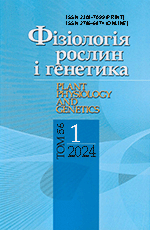In pot experiment the ontogenetic dynamics of gas exchange rate of subflag and flag leaves of different winter wheat varieties were studied. It was revealed that the maximum net assimilation rate of subflag leaf was higher than that of flag, but during the grain forming it reduced dramatically and flag leaf played the leading role in supplying of ear with assimilates. The linear correlation was found between nitrogen content in flag leaf and net assimilation rate during the period earing—wax ripeness of grain. It was determined the lower physiological limit of nitrogen content in the leaf for photosynthetic CO2 assimilation, which is about 0.7 % of dry weigh. It is shown that the rate of flag leaf transpiration during the period of grain filling was more stable than the rate of photosynthesis. This accounts for less stomata apparatus dependence on nitrogen content in the leaf, which gradually decreased due to this element remobilization to grain.
Keywords: Triticum aestivum L., photosynthesis, transpiration, nitrogen, ontogeny, productivity
Full text and supplemented materials
Free full text: PDFReferences
1. Kiriziy, D.A. & Ryzhikova, P.L. (2017). Varietal peculiarities of nitrogen remobilization from the vegetative parts of wheat shoot under different levels of mineral nutrition. Fiziol. rast. genet., 49, No. 1, pp. 15-24 [in Ukrainian].
2. Kiriziy, D.A., Stasik, O.O., Pryadkina, G.A. & Shadchina, T.M. (2014). Photosynthesis. T. 2. Assimilation of CO2 and the mechanisms of its regulation. Kyiv: Logos [in Russian].
3. Kiriziy, D.A., Shadchina, T.M., Stasik, O.O., Priadkina, H.O., Sokolovska-Serhiienko, O.H., Huliaiev, B.I. & Sytnyk, S.K. (2011). Peculiarities of photosynthesis and production process of winter wheat high intensity genotypes. Kyiv: Osnova [in Ukrainian].
4. Morgun, V.V. & Kiriziy, D.A. (2012). Prospects and modern strategies of wheat physiological traits improvement for increasing productivity. Fiziologia i biokhimia kulturnykh rasteniy, 44, No. 6, pp. 463-483 [in Ukrainian].
5. Morgun V.V, Sanin Y.V. & Schwartau V.V. (2015). The club 100 centners. Winter wheat varieties of the Institute of Plant Physiology and Genetics of the National Academy of Sciences of Ukraine and the protection system of Syngenta. Kyiv: Logos [in Ukrainian].
6. Morgun, V.V., Stasik, O.O., Frantiichuk, V.V., Kiriziy, D.A. & Sytnyk, S.K. (2016). Analysis of relationships between the photosynthetic traits of flag leaf and the components of spike productivity in winter wheat varieties of different selection periods. Fiziol. rast. genet., 48, No. 4, pp. 356-365 [in Russian].
7. Pochinok, H.N. (1976). Methods for biochemical analysis of plants. Kyiv: Naukova dumka [in Russian].
8. Stasik, O.O., Kiriziy, D.A. & Priadkina, H.O. (2016). Photosynthesis and crop productivity. Fiziol. rast. genet., 48, No. 3, pp. 232-251 [in Russian].
9. Mokronosov, A.T., Kovalev, A.G. (Eds.) (1989). Photosynthesis and bioproductivity: methods for determination. Moscow: Agropromizdat [in Russian].
10. Bertheloot, J., Martre, P. & Andrieu, B. (2008). Dynamics of light and nitrogen distribution during grain filling within wheat canopy. Plant Physiol., 148, No. 3, pp. 1707-1720. https://doi.org/10.1104/pp.108.124156
11. Fischer R.A. (2007). Understanding the physiological basis of yield potential in wheat. J. Agr. Sci. 145, No. 2, pp. 99-113. https://doi.org/10.1017/S0021859607006843
12. Gaju, O., Allard, V., Martre, P. Le Gouis, J., Moreau, D., Bogard, M., Hubbart, S. & Foulkes, M.J. (2014). Nitrogen partitioning and remobilization in relation to leaf senescence, grain yield and grain nitrogen concentrationin wheat cultivars. Field Crops Res., 155, pp. 213-223. https://doi.org/10.1016/j.fcr.2013.09.003
13. Have, M., Marmagne, A., Chardon, F. & Masclaux-Daubresse, C. (2016). Nitrogen remobilisation during leaf senescence: lessons from Arabidopsis to crops. Exp. Bot., 68, No.10, pp. 2513-2529. https://doi.org/10.1093/jxb/erw365
14. Jaikuma,r N.S., Snapp, S.S., Flore, J.A. & Loescher, W. (2014). Photosynthetic responses in annual rye, perennial wheat, and perennial rye subjected to modest source:sink ratio changes. Crop Sci., 54, No. 1, pp. 274-283. https://doi.org/10.2135/cropsci2013.04.0280
15. Makino, A. (2011). Photosynthesis, grain yield, and nitrogen utilization in rice and wheat. Plant Physiol., 155, No. 1, pp. 125-129. https://doi.org/10.1104/pp.110.165076
16. Mukherjee, J., Singh, G. & Bal, S.K. (2014) Radiation use efficiency and instantaneous photosynthesis at different growth stages of wheat (Triticum aestivum L.) in semi arid ecosystem of Central Punjab, India. J. Agrometeorology, 16, No. 1, pp. 69-77.
17. Parry, M.A., Reynolds, M., Salvucci, M.E., Raines, C., Andralojc, P.J., Zhu, X.G., Price, G.D., Condon, A.G. & Furbank, R.T. (2011). Raising yield potential of wheat. II. Increasing photosynthetic capacity and efficiency. J. Exp. Bot., 62, No. 2, pp. 453-467. https://doi.org/10.1093/jxb/erq304
18. Raines, C.A. (2011). Increasing photosynthetic carbon assimilation in C3 plants to improve crop yield: current and future strategies. Plant Physiol., 155, No. 1, pp. 36-42. https://doi.org/10.1104/pp.110.168559
19. Shao, L., Zhang, X., Hideki, A., Tsuji, W., Chen, S. (2010). Effects of defoliation on grain yield and water use of winter wheat. J. Agr. Sci., 148, No. 2, pp. 191-204. https://doi.org/10.1017/S0021859609990542
20. Zheng, T.C., Zhang, X.K., Yin, G.H., Wang, L.N., Han, Y.L., Chen, L., Huang, F., Tang, J.W., Xia, X.C., He, Z.H. (2011). Genetic gains in grain yield, net photosynthesis and stomatal conductance achieved in Henan Province of China between 1981 and 2008. Field Crops Res., 122, No. 3, pp. 225-233. https://doi.org/10.1016/j.fcr.2011.03.015
